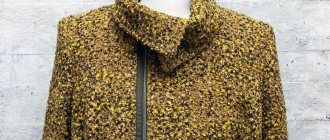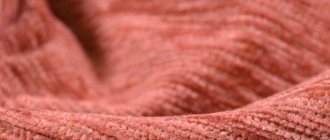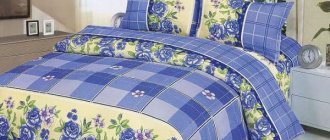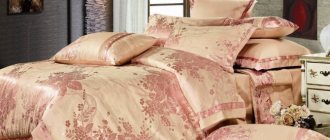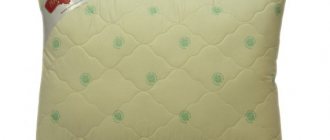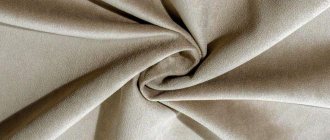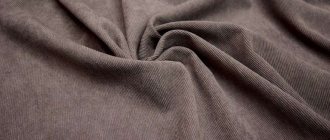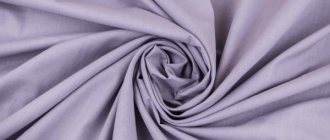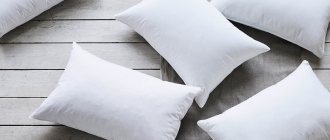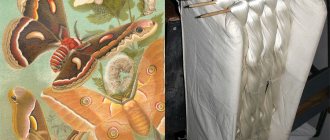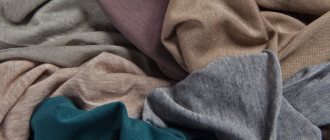Polyester can be found in almost any item in every person’s wardrobe. This material has long been firmly established in our lives. Despite its synthetic origin, high-quality polyester is safe, comes in a variety of shades, has a high level of practicality and is affordable. But does he really have only positive qualities? To answer this question, it is worth understanding what kind of fabric polyester is. The pros and cons of the material and its scope of application are discussed in our article.
Production Features
Polyester production technology was invented in the 40s of the last century. The material was obtained on the basis of oil, gas, coal, acids, alcohol products with the addition of air and water.
The complex technological process of polyester production includes several main stages:
- Identification of the main raw material components necessary for the production of the material.
- Obtaining a melt, which is the liquid base of polyester.
- Multi-level cleaning.
- Obtaining fibers by passing a liquid solution through small holes.
- Their further finishing is to give the threads the necessary qualities.
- Direct production of material.
The variety of properties of polyester fiber is achieved by introducing various changes during its production. Therefore, it is worth considering the main pros and cons of polyester, depending on its further use.
Description of material
Polyester is produced both in its pure form and with the addition of cotton, wool, viscose and other fibers. For this reason, the final material may differ radically in appearance and feel. Its surface can be matte or shiny, it can have both a dense and thin structure.
In terms of its characteristics, polyester is similar to cotton, and in appearance - to wool. A high-quality sample of the material does not leave marks on the skin when worn, does not have any odor and does not fade when washed.
This synthetic material is capable of changing shape at a temperature of 40 degrees, but this property is both positive and negative. Thanks to this, the material is ideal for creating the necessary folds on the product. If you do not take this property into account when ironing, you can involuntarily deform the fabric, which will ruin the overall appearance of the item.
This quality should also be taken into account when washing the material. Useful quality of the fabric - polyester is easily washed from dirt even in cool water.
Thanks to these properties, the material is distinguished by its versatility. It is used equally for sewing clothes, shoes, lining, and for the production of blankets, carpets, bags, and backpacks.
Benefits of fabric
Polyester has most of the qualities that consumers value so much. But in its pure form, the material is used extremely rarely, since its combination with other fibers makes it possible to obtain higher quality products.
The main advantages of polyester:
- Wear-resistant.
- Easy to care for.
- Doesn't shed.
- Does not fade under the influence of ultraviolet radiation.
- Doesn't roll down.
- Dries quickly.
- Retains its shape during long-term use.
- Keeps warm.
- Doesn't get wet.
- Does not cause allergies.
- When in contact with the skin it creates a pleasant sensation.
- Resistant to dirt and grease.
- It is easy to paint, therefore it has a diverse selection of shades.
- Does not absorb foreign odors.
- Affordable price.
Important Takeaways
Polyester is a unique fabric with a number of undeniable advantages. To make it, it is necessary to carry out a complex chemical reaction. However, this does not stop manufacturers.
In addition, this material is considered the most popular among synthetic analogues. It is wear-resistant, inexpensive and easy to maintain.
Have you ever come across products that literally fascinated you with their softness and practicality? It turns out that fleece fabric, which is discussed in our article, has these advantages.
If you prefer beautiful natural materials, then cambric with embroidery is an excellent choice. Let's look at its positive qualities using this link.
What are they - the fabrics of the future? Let's look:
© 2021 textiletrend.ru
Flaws
Like any other material, polyester has not only pros, but also cons. But this mainly applies only to 100% polyester fiber.
Main disadvantages:
- Increased rigidity.
- The ability to become electrified.
- Cannot be bleached.
- Too dense structure for hot weather.
- Highly flammable.
Despite the existing disadvantages of polyester, it does not lose its relevance, since by combining it with other fibers, all disadvantages are reduced to a minimum.
What is the approximate price for selling?
The price of one meter of fabric varies greatly and depends on many factors: the manufacturer, the content of other fibers, the width of the fabric, and varies from 100 to 1000 rubles. On average, fabric can be bought in stores selling fabrics for 300 rubles per 1 meter.
Despite the impressive list of disadvantages inherent in polyester, this fabric will remain in demand among buyers and manufacturers of clothing, accessories and items for sports and tourism for a long time. In addition, it is the most popular material among other synthetic fabrics.
Polyester based clothing
This material is especially popular in the production of clothing. This is explained by the fact that polyester is easy to dye, and the shades are bright and varied. In addition, synthetic fibers retain their shape well and are resistant to stains, making them ideal for sewing items for everyday use.
The use of polyester in clothing has made it available to a wide range of consumers, since its prices are significantly lower than the cost of natural materials. Items made from synthetic fibers do not require special care. If you follow the manufacturer's recommendations, they retain their qualities and properties for a long time. Polyester is used for sewing dresses, suits, skirts, T-shirts, underwear, hosiery, and lining.
Advantages of things made from this material:
- In appearance they are not inferior to natural products.
- Differ in a variety of shades.
- They do not lose their properties under the influence of ultraviolet radiation, frost and moisture.
- They do not require special care.
- Resistant to stains.
The disadvantages of polyester products include the following:
- Low level of breathability, so it is better not to use them in hot weather.
- Washing at high temperatures and bleaching lead to deformation of products, so it is recommended to carefully study the manufacturer's recommendations on the label.
Based on the pros and cons of polyester clothing, we can conclude that this material is universal in use. Despite its shortcomings, its use in tailoring contributes to the diversification of the range of goods and the reduction of their cost.
What standards are used in production? What do they take into account?
When producing fabrics from polyester fibers, the standards prescribed in GOST 23433-79 are used. Fabrics and piece goods made from chemical fibers.”
It talks about color fastness to:
- light - according to GOST 9733.1-91;
- washing - according to GOST 9733.4-83;
- ironing - according to GOST 9733.7-83;
- friction - according to GOST 9733.27-83;
And:
- air permeability - according to GOST 29298-2005;
- tensile tensile characteristics - according to GOST 3813-72;
- determination of water resistance - according to GOST 3816.
Pros and cons of polyester thermal underwear
Thermal underwear is underwear that maintains normal body temperature and helps remove moisture into the upper layers of clothing.
Wool and polyester are often used to produce thermal underwear. Unlike natural material, synthetic fiber allows you to maintain the required body temperature not only in winter, but also in summer. This is achieved due to the fact that polyester with special additives is able not only to retain heat, but also to cool the skin from overheating during the heat.
This quality of material is especially important for professional athletes who experience physical activity constantly and in any weather. Therefore, you should familiarize yourself with the pros and cons of polyester when using material for underwear.
The main advantages include:
- Maintaining a comfortable body temperature.
- Easy to wash.
- Dries quickly.
- Has increased wear resistance and strength.
- Does not lose shape with prolonged use.
- Doesn't roll down.
Synthetic fiber underwear also has some disadvantages. It is advisable to take them into account when purchasing these products.
Flaws:
- is electrified, so regular use of an antistatic agent is necessary.
- Requires daily washing as it retains the smell of sweat.
Where are fibers used?
Polyester is part of most textile products that surround us.
- It is in demand in the production of waterproof tents, awnings, sleeping bags and protective outerwear. The products protect against the penetration of moisture and wind.
- For the everyday wardrobe of adults and children: jackets, trousers, suits, skirts, dresses and shirts.
- For uniforms and workwear.
- Artificial fur.
- Underwear products, stockings and socks.
- In outerwear for the winter and autumn seasons filled with padding polyester, holofiber and others.
- Home textiles - curtains, tablecloths, napkins and bedspreads.
- Colorful and practical bedding sets.
- Hats and accessories - umbrellas and bags, scarves and gloves.
- Tracksuits, tight-fitting clothing and leggings.
- Furniture and upholstery fabrics.
- Children's toys and decorative items.
Important! Material with polyester is distinguished by a specific surface shine and some roughness upon tactile contact. If you lightly rub the canvas in your hand, you will hear a synthetic squeak.
Polyester based shoes
Shoe manufacturers have not ignored this material either. Thanks to the use of polyester in this industry, it has become possible to significantly increase the wear resistance and durability of products. It is often used when sewing sports shoes, since they are subject to increased functional loads.
In addition, the material does not absorb moisture, is resistant to wear and does not require special care. But these qualities are especially important for shoes.
But before you finally make a choice, you should take into account the main pros and cons of polyester shoes.
Main advantages;
- Resistant to temperature changes.
- Preservation of shape and color.
- Moisture resistant.
- Durability.
- Strength.
- Affordable price.
- Possibility of manufacturing any model.
The disadvantages of polyester shoes include low breathability, although this problem can be solved by choosing more open models or using products in the cool season.
Application when sewing outerwear
In this case, polyester is used in three different versions: for the top of the products, lining and insulating filler. This versatility of use has allowed manufacturers to significantly improve the quality of outerwear, reduce their specific weight, increase heat conservation and reduce cost.
The most popular filling for polyester-based outerwear is holofiber. This material is distinguished by its lightness, porous structure and high heat transfer. It is important that it retains its properties and shape during washing and long-term use.
Most often in the store you can find demi-season and winter jackets made of polyester. The pros and cons of these products should be studied in detail so that when purchasing a person is confident in their choice.
Advantages:
- Ease.
- Strength.
- Easy to care for.
- Preservation of its properties if there is snow, rain, wind, or frost outside.
- UV resistance.
- Heat retention.
- Low percentage of creasing (does not wrinkle).
- Abrasion resistance.
- Immunity to organic solvents.
The disadvantages of polyester-based outerwear include the fact that when washed above 40 degrees, the products lose their shape and acquire an unsightly appearance. Therefore, the main condition for the durability of polyester products is compliance with the manufacturer’s care recommendations.
Care
Materials with polyester fiber are easy to care for. To maintain attractiveness and preserve properties, the following rules must be observed:
- Some products made from polyethylene threads cannot be washed. You should always look at the label for accurate information.
- All detergent compositions in the form of powders, gels or capsules, previously diluted in water, are suitable for care.
Advice! It is prohibited to bleach polyester fabrics. Aggressive chemistry destroys fibers and the fabric wears out faster.
- The temperature when washing should be maintained within 30-40°. Exceeding is fraught with loss of shape.
- In the machine, use the delicate mode and spin at a maximum of 800 rpm.
- Conditioners and rinses will soften the fibers and help get rid of static.
- The products wrinkle little and rarely require ironing. Iron fabrics with polyester fibers from the reverse side using the “silk” heating mode of the iron.
- Dry cleaning allowed.
Polyester blankets
In the production of blankets and pillows, polyester is used as a filler for products. This makes them lighter, improves heat transfer and significantly extends their service life. In addition, polyester blankets and pillows are excellent for transportation, so they can be used on camping trips and long trips, as they do not take up much space and do not weigh down luggage.
The advantages of a polyester-based blanket include:
- Ease.
- High heat transfer.
- There are no parasites.
- Durability.
- Minimal care.
- Does not cause allergies.
- Does not absorb foreign odors.
- Has high elasticity.
The disadvantage of these products is the low percentage of moisture absorption. They will also make them appear too warm for some people.
Based on the pros and cons of polyester blankets, we can judge that this synthetic material is universal. His invention made it possible to significantly improve the quality of these products and reduce their cost.
Advantages and disadvantages of carpets
Polyester is also used in the production of carpets. This made it possible to significantly expand the range of products offered and increase their service life.
Main advantages:
- Strength.
- Variety of colors.
- Presentable appearance.
- Stain resistant.
- Excellent value for money and quality.
The disadvantages include the inability to use bleaching agents, but this problem can be solved by choosing darker shades of the coating.
Having studied the pros and cons of polyester carpets, we can safely say that these products have a long service life without loss of their qualities, provided that all care recommendations are followed.
